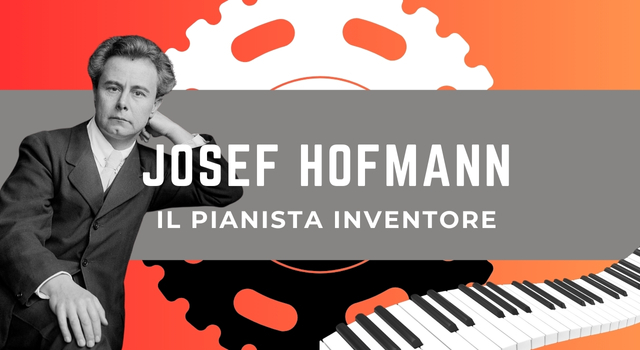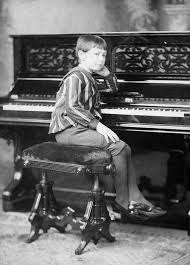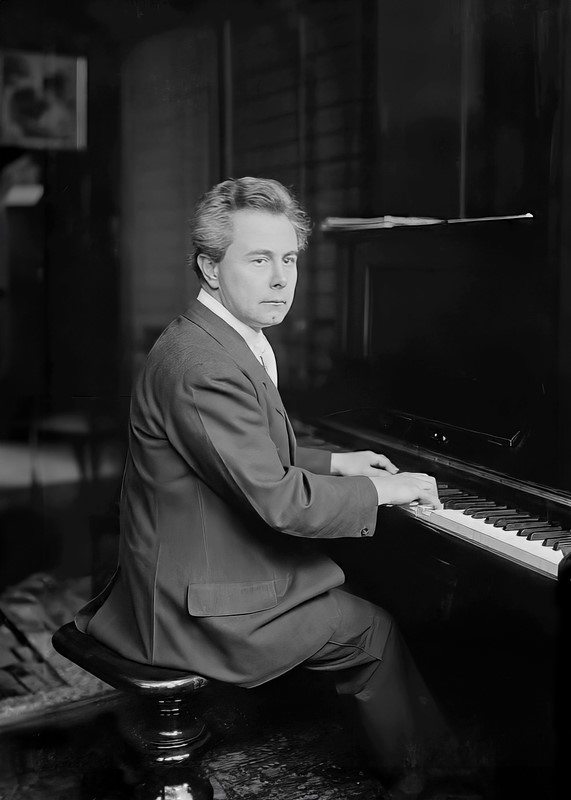Josef Hofmann – The Pianist Inventor
Many know Josef Hofmann as an exceptional pianist, but how many are aware that he was also a prolific inventor? He was a brilliant mind who found fulfillment not only at the piano but also through numerous patents, channeling his immense passion for mechanics and technology across a variety of fields. But who was Josef Hofmann?

The Pianist
Born in 1876 in Podgórze, a district of Krakow, Hofmann came from a family of artists – his mother was an actress and vaudeville singer, and his father was a composer, pianist, and conductor. His genius quickly became evident through his incredible musical talents. Destined to become a child prodigy like Mozart, Hofmann performed Beethoven’s Piano Concerto No. 1 as a soloist at just nine years old, under the baton of the renowned Hans von Bülow with the Berlin Philharmonic. That concert launched a touring career that brought young Josef to the stages of major theaters across Europe and later the United States, where he astonishingly gave 52 concerts in just three months.
 Such prodigious talent couldn’t go unnoticed. However, the Society for the Prevention of Cruelty to Children intervened to halt Hofmann’s intense concert schedule, launching a media campaign highlighting this form of child exploitation. To resolve the situation, Alfred Corning Clark, a magnate and patron, offered the Hofmann family a substantial sum to keep Josef away from the concert stage until he turned eighteen and received a proper education. Following this, the young prodigy returned to Poland and later moved to Berlin, where he studied with illustrious teachers like Moritz Moszkowski, Ignacy Paderewski, Wanda Landowska, and Heinrich Urban. Although comprehensive biographies are scarce, we know for certain – because Hofmann himself mentioned it – that he was the only private student of the great Anton Rubinstein. Hofmann revered Rubinstein and valued the creative freedom the maestro allowed him, aiming to stimulate original thinking in the pianist and as interpreter.
Such prodigious talent couldn’t go unnoticed. However, the Society for the Prevention of Cruelty to Children intervened to halt Hofmann’s intense concert schedule, launching a media campaign highlighting this form of child exploitation. To resolve the situation, Alfred Corning Clark, a magnate and patron, offered the Hofmann family a substantial sum to keep Josef away from the concert stage until he turned eighteen and received a proper education. Following this, the young prodigy returned to Poland and later moved to Berlin, where he studied with illustrious teachers like Moritz Moszkowski, Ignacy Paderewski, Wanda Landowska, and Heinrich Urban. Although comprehensive biographies are scarce, we know for certain – because Hofmann himself mentioned it – that he was the only private student of the great Anton Rubinstein. Hofmann revered Rubinstein and valued the creative freedom the maestro allowed him, aiming to stimulate original thinking in the pianist and as interpreter.
Under Rubinstein’s mentorship, Hofmann returned to concert performance in 1894. In the early years of the 20th century – often accompanied by his wife Marie – Hofmann embarked on several tours in Russia and the United States. During a stop in Tbilisi in 1911, he deepened his acquaintance with Rachmaninov, leading to a relationship of mutual respect and deep friendship. Rachmaninov’s Piano Concerto No. 3 is dedicated to Hofmann. Josef’s success in Russia was extraordinary.
When war broke out, returning to the United States was challenging for Hofmann due to his origins. In the meantime, he also pursued composition, an endeavor he modestly undertook under the pseudonym Michel Dvorsky. He served as director of the Curtis Institute of Music in Philadelphia until 1938 and continued his concert career thereafter. Hofmann retired only in 1947, beset by various problems, including alcoholism, he died of a heart attack in Los Angeles ten years later, in 1957.
The Inventor
 Josef Hofmann’s creative power and genius also shone in a field entirely separate from music. Beyond music, his greatest love was mechanics. It’s said that he filed over sixty patents, designing solutions for a wide array of applications – from automotive innovations to projects naturally related to the piano. Reportedly, he built a car and developed a precursor to the modern GPS system to improve positional accuracy. His genius led to inventions like shock absorbers and the spring-loaded bumper – the list goes on. And let’s not forget his patent for the windshield wiper, inspired by the oscillating movement of the metronome. Hofmann the inventor devised practical solutions implemented in balloons and airplanes, created a spiral heater for boiling water, and invented an electric clock. He also proposed ideas to improve the pianist’s experience. Steinway crafted a keyboard with narrower keys for those with small hands like his. He conceived pedal extensions for the piano for players who, like him as a child, weren’t tall enough to reach them, and he designed the height-adjustable piano bench as we know it today.
Josef Hofmann’s creative power and genius also shone in a field entirely separate from music. Beyond music, his greatest love was mechanics. It’s said that he filed over sixty patents, designing solutions for a wide array of applications – from automotive innovations to projects naturally related to the piano. Reportedly, he built a car and developed a precursor to the modern GPS system to improve positional accuracy. His genius led to inventions like shock absorbers and the spring-loaded bumper – the list goes on. And let’s not forget his patent for the windshield wiper, inspired by the oscillating movement of the metronome. Hofmann the inventor devised practical solutions implemented in balloons and airplanes, created a spiral heater for boiling water, and invented an electric clock. He also proposed ideas to improve the pianist’s experience. Steinway crafted a keyboard with narrower keys for those with small hands like his. He conceived pedal extensions for the piano for players who, like him as a child, weren’t tall enough to reach them, and he designed the height-adjustable piano bench as we know it today.
Hofmann also engaged with the realm of piano recording. As a child, Thomas Edison recorded him playing on a phonograph Edison had invented. The recording was made on special wax cylinders so delicate that they were unfortunately lost. After retiring from concert life, Hofmann devoted much of his time to studying ways to enhance the piano’s sound quality in the recording process, experimenting with various amplification methods and continually developing new devices. Josef Hofmann was a versatile and eclectic personality – a pianist and ingenious creator who, unfortunately, is still not widely discussed.
For those interested in delving deeper into Hofmann’s pianism and interpretation philosophy, Piero Rattalino’s book Josef Hofmann – The Sphinx (Zecchini Editore) is highly recommended.
Other recommended books:
Josef Hofmann: Piano Playing and Questions Answered
Elisabeth Carr: Josef Hofmann – The Piano’s Forgotten Giant
 Pianosolo.it is a project in favor of thousands of Italian speaking people with a common passion: the piano. Online since 2008, pianosolo.it was the first Italian blog completely dedicated to this theme. It offers daily news, lessons with video tutorials, interviews, reviews, in-depth articles, reports and opinions on piano world news, pursuing the aim of a widespread dissemination of musical culture at all levels.
Pianosolo.it is a project in favor of thousands of Italian speaking people with a common passion: the piano. Online since 2008, pianosolo.it was the first Italian blog completely dedicated to this theme. It offers daily news, lessons with video tutorials, interviews, reviews, in-depth articles, reports and opinions on piano world news, pursuing the aim of a widespread dissemination of musical culture at all levels.
Comments